BIOL121 Worksheet: Cells, Muscles, Hormones, and Urine Formation
VerifiedAdded on 2023/06/05
|9
|2686
|336
AI Summary
This BIOL121 worksheet covers a variety of topics related to cells, muscles, hormones, and urine formation. It includes questions on the role of different cells in the body, personal protective equipment, autonomic innervation, and more. The worksheet also covers the effects of hormones such as antidiuretic hormone and aldosterone on water and electrolyte balance, as well as the three elementary steps of urine formation. The questions are designed to test the student's knowledge and understanding of these topics.
Contribute Materials
Your contribution can guide someone’s learning journey. Share your
documents today.
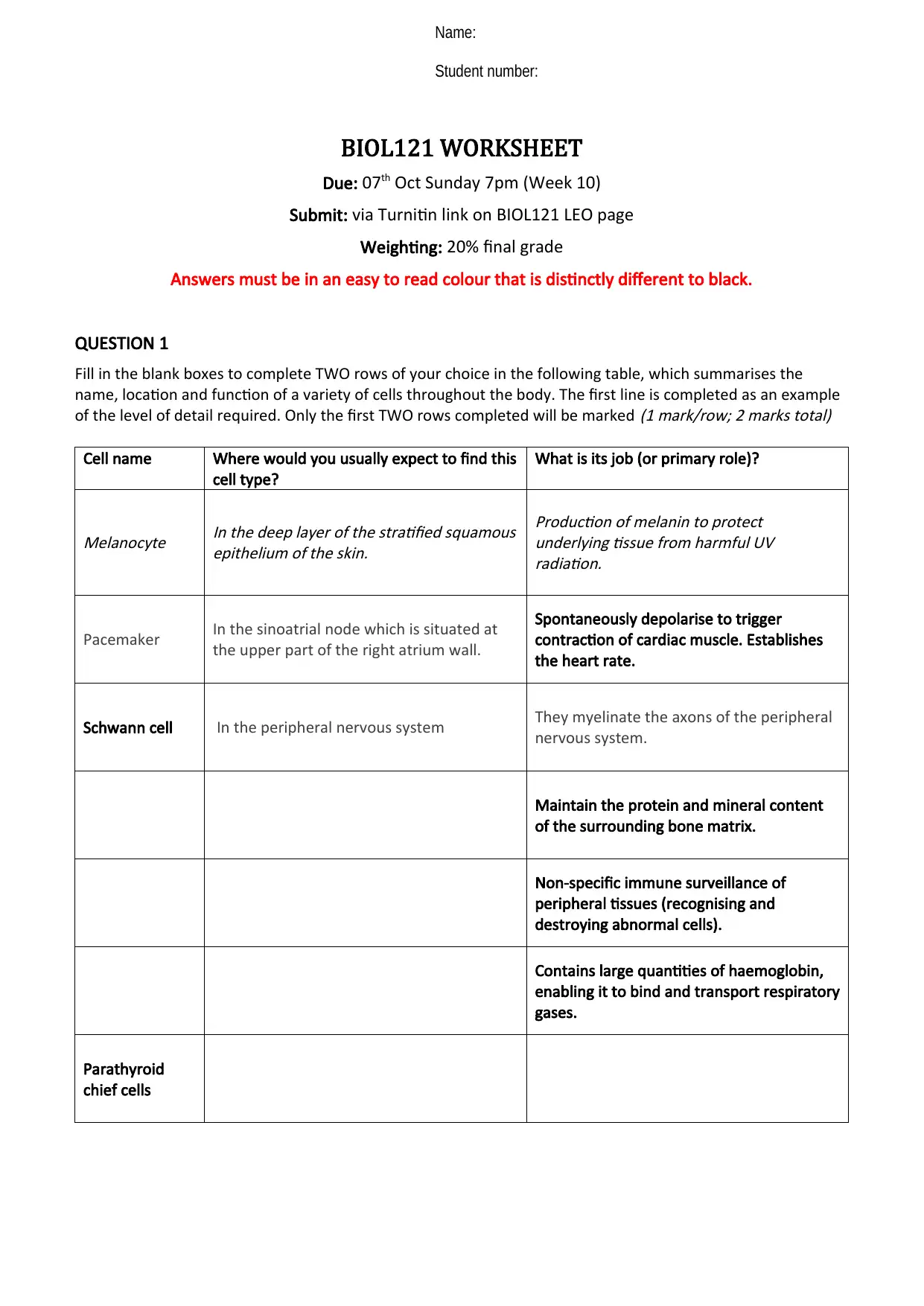
Name:
Student number:
BIOL121 WORKSHEET
Due: 07th Oct Sunday 7pm (Week 10)
Submit: via Turnitin link on BIOL121 LEO page
Weighting: 20% final grade
Answers must be in an easy to read colour that is distinctly different to black.
QUESTION 1
Fill in the blank boxes to complete TWO rows of your choice in the following table, which summarises the
name, location and function of a variety of cells throughout the body. The first line is completed as an example
of the level of detail required. Only the first TWO rows completed will be marked
(1 mark/row; 2 marks total)
Cell name Where would you usually expect to find this
cell type?
What is its job (or primary role)?
Melanocyte
In the deep layer of the stratified squamous
epithelium of the skin.
Production of melanin to protect
underlying tissue from harmful UV
radiation.
Pacemaker In the sinoatrial node which is situated at
the upper part of the right atrium wall.
Spontaneously depolarise to trigger
contraction of cardiac muscle. Establishes
the heart rate.
Schwann cell In the peripheral nervous system They myelinate the axons of the peripheral
nervous system.
Maintain the protein and mineral content
of the surrounding bone matrix.
Non-specific immune surveillance of
peripheral tissues (recognising and
destroying abnormal cells).
Contains large quantities of haemoglobin,
enabling it to bind and transport respiratory
gases.
Parathyroid
chief cells
Student number:
BIOL121 WORKSHEET
Due: 07th Oct Sunday 7pm (Week 10)
Submit: via Turnitin link on BIOL121 LEO page
Weighting: 20% final grade
Answers must be in an easy to read colour that is distinctly different to black.
QUESTION 1
Fill in the blank boxes to complete TWO rows of your choice in the following table, which summarises the
name, location and function of a variety of cells throughout the body. The first line is completed as an example
of the level of detail required. Only the first TWO rows completed will be marked
(1 mark/row; 2 marks total)
Cell name Where would you usually expect to find this
cell type?
What is its job (or primary role)?
Melanocyte
In the deep layer of the stratified squamous
epithelium of the skin.
Production of melanin to protect
underlying tissue from harmful UV
radiation.
Pacemaker In the sinoatrial node which is situated at
the upper part of the right atrium wall.
Spontaneously depolarise to trigger
contraction of cardiac muscle. Establishes
the heart rate.
Schwann cell In the peripheral nervous system They myelinate the axons of the peripheral
nervous system.
Maintain the protein and mineral content
of the surrounding bone matrix.
Non-specific immune surveillance of
peripheral tissues (recognising and
destroying abnormal cells).
Contains large quantities of haemoglobin,
enabling it to bind and transport respiratory
gases.
Parathyroid
chief cells
Secure Best Marks with AI Grader
Need help grading? Try our AI Grader for instant feedback on your assignments.
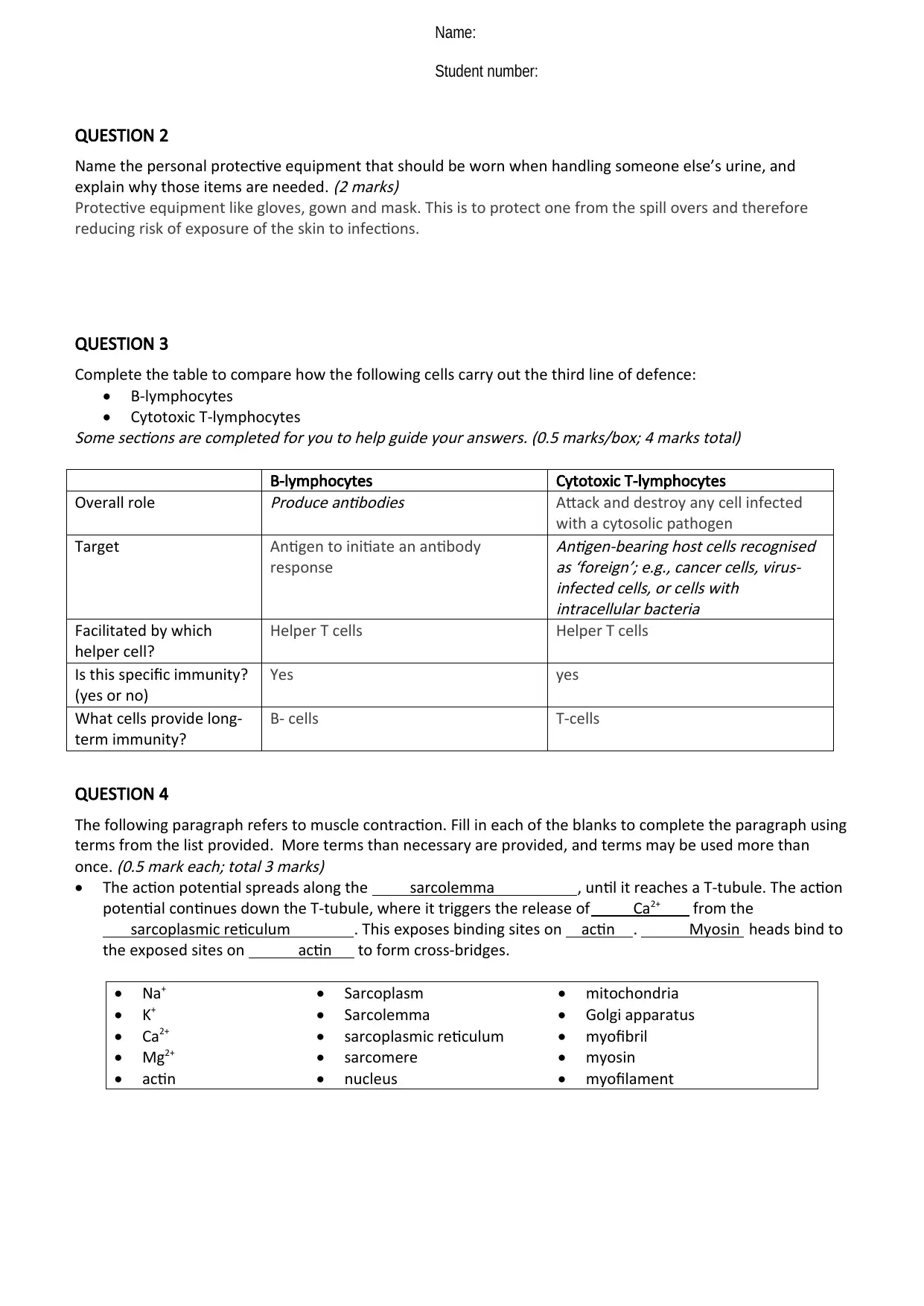
Name:
Student number:
QUESTION 2
Name the personal protective equipment that should be worn when handling someone else’s urine, and
explain why those items are needed.
(2 marks)
Protective equipment like gloves, gown and mask. This is to protect one from the spill overs and therefore
reducing risk of exposure of the skin to infections.
QUESTION 3
Complete the table to compare how the following cells carry out the third line of defence:
B-lymphocytes
Cytotoxic T-lymphocytesSome sections are completed for you to help guide your answers. (0.5 marks/box; 4 marks total)
B-lymphocytes Cytotoxic T-lymphocytes
Overall role
Produce antibodies Attack and destroy any cell infected
with a cytosolic pathogen
Target Antigen to initiate an antibody
response
Antigen-bearing host cells recognised
as ‘foreign’; e.g., cancer cells, virus-
infected cells, or cells with
intracellular bacteria
Facilitated by which
helper cell?
Helper T cells Helper T cells
Is this specific immunity?
(yes or no)
Yes yes
What cells provide long-
term immunity?
B- cells T-cells
QUESTION 4
The following paragraph refers to muscle contraction. Fill in each of the blanks to complete the paragraph using
terms from the list provided. More terms than necessary are provided, and terms may be used more than
once.
(0.5 mark each; total 3 marks)
The action potential spreads along the sarcolemma , until it reaches a T-tubule. The action
potential continues down the T-tubule, where it triggers the release of Ca2+ from the
sarcoplasmic reticulum . This exposes binding sites on actin . Myosin heads bind to
the exposed sites on actin to form cross-bridges.
Na+ Sarcoplasm mitochondria
K+ Sarcolemma Golgi apparatus
Ca2+
Mg2+
sarcoplasmic reticulum
sarcomere
myofibril
myosin
actin nucleus myofilament
Student number:
QUESTION 2
Name the personal protective equipment that should be worn when handling someone else’s urine, and
explain why those items are needed.
(2 marks)
Protective equipment like gloves, gown and mask. This is to protect one from the spill overs and therefore
reducing risk of exposure of the skin to infections.
QUESTION 3
Complete the table to compare how the following cells carry out the third line of defence:
B-lymphocytes
Cytotoxic T-lymphocytesSome sections are completed for you to help guide your answers. (0.5 marks/box; 4 marks total)
B-lymphocytes Cytotoxic T-lymphocytes
Overall role
Produce antibodies Attack and destroy any cell infected
with a cytosolic pathogen
Target Antigen to initiate an antibody
response
Antigen-bearing host cells recognised
as ‘foreign’; e.g., cancer cells, virus-
infected cells, or cells with
intracellular bacteria
Facilitated by which
helper cell?
Helper T cells Helper T cells
Is this specific immunity?
(yes or no)
Yes yes
What cells provide long-
term immunity?
B- cells T-cells
QUESTION 4
The following paragraph refers to muscle contraction. Fill in each of the blanks to complete the paragraph using
terms from the list provided. More terms than necessary are provided, and terms may be used more than
once.
(0.5 mark each; total 3 marks)
The action potential spreads along the sarcolemma , until it reaches a T-tubule. The action
potential continues down the T-tubule, where it triggers the release of Ca2+ from the
sarcoplasmic reticulum . This exposes binding sites on actin . Myosin heads bind to
the exposed sites on actin to form cross-bridges.
Na+ Sarcoplasm mitochondria
K+ Sarcolemma Golgi apparatus
Ca2+
Mg2+
sarcoplasmic reticulum
sarcomere
myofibril
myosin
actin nucleus myofilament

Name:
Student number:
QUESTION 5
Describe the role of osteoblasts and osteoclasts in the regulation of blood calcium ion concentration. You must
include the role of the relevant hormones for full marks.
(3 marks)
The action of osteoclasts is stimulated by Parathyroid hormone when the level of calcium in blood falls. This
leads to calcium being transferred from bone to blood. Calcitonin on the other hand lowers the osteoclasts
activity and thereby reducing the breakdown of bone.
QUESTION 6
Describe how the hypothalamus controls the release of hormones from the:
A. anterior lobe of pituitary gland
B. posterior lobe of the pituitary gland
In your answer, give specific examples and clearly name any hormones involved.
(2 marks/lobe)
The anterior lobe will produce hormones upon getting the inhibiting or releasing hormones from the
hypothalamus. For example, the release of Growth Hormone Releasing Hormone and Growth Hormone
Inhibiting Hormone from hypothalamus controls the levels of Growth hormone release by anterior lobe.
The posterior lobe has nerve endings cells from the hypothalamus whereby the hypothalamus sends hormones
straight to this lobe through this nerves and then they are released by pituitary gland. For example, during
suckling by a baby, sensory receptors found in the nipple sends signals to hypothalamus and in turn oxytocin is
secreted and released to bloodstream.
QUESTION 7
Duchenne muscular dystrophy (DMD) is recessive sex-linked disorder, which causes muscle degeneration and
premature death. A couple is pregnant with a boy and neither has DMD. The father’s family has no history of
DMD, but the mother is unsure of her genetic family history as she was adopted. The mother decides to take
advantage of some of the new genomic screening tests and learns information about a large number of her
genes. She finds that she is a carrier of the DMD-affected allele.
(3 marks total)
A. What is the mother’s genotype? Explain your reasoning.
(1 mark)
XdX. this is because the dominant allele will be seen but the individual will still be having recessive trait gene.
B. What is the father’s genotype? Explain your reasoning.
(1 mark)
XY. Because he has no history of DMD in the family.
C. What is the likelihood of the male foetus having DMD? Use a Punnett square to explain your answer.
(1
mark)
Mother’s genotype
Student number:
QUESTION 5
Describe the role of osteoblasts and osteoclasts in the regulation of blood calcium ion concentration. You must
include the role of the relevant hormones for full marks.
(3 marks)
The action of osteoclasts is stimulated by Parathyroid hormone when the level of calcium in blood falls. This
leads to calcium being transferred from bone to blood. Calcitonin on the other hand lowers the osteoclasts
activity and thereby reducing the breakdown of bone.
QUESTION 6
Describe how the hypothalamus controls the release of hormones from the:
A. anterior lobe of pituitary gland
B. posterior lobe of the pituitary gland
In your answer, give specific examples and clearly name any hormones involved.
(2 marks/lobe)
The anterior lobe will produce hormones upon getting the inhibiting or releasing hormones from the
hypothalamus. For example, the release of Growth Hormone Releasing Hormone and Growth Hormone
Inhibiting Hormone from hypothalamus controls the levels of Growth hormone release by anterior lobe.
The posterior lobe has nerve endings cells from the hypothalamus whereby the hypothalamus sends hormones
straight to this lobe through this nerves and then they are released by pituitary gland. For example, during
suckling by a baby, sensory receptors found in the nipple sends signals to hypothalamus and in turn oxytocin is
secreted and released to bloodstream.
QUESTION 7
Duchenne muscular dystrophy (DMD) is recessive sex-linked disorder, which causes muscle degeneration and
premature death. A couple is pregnant with a boy and neither has DMD. The father’s family has no history of
DMD, but the mother is unsure of her genetic family history as she was adopted. The mother decides to take
advantage of some of the new genomic screening tests and learns information about a large number of her
genes. She finds that she is a carrier of the DMD-affected allele.
(3 marks total)
A. What is the mother’s genotype? Explain your reasoning.
(1 mark)
XdX. this is because the dominant allele will be seen but the individual will still be having recessive trait gene.
B. What is the father’s genotype? Explain your reasoning.
(1 mark)
XY. Because he has no history of DMD in the family.
C. What is the likelihood of the male foetus having DMD? Use a Punnett square to explain your answer.
(1
mark)
Mother’s genotype
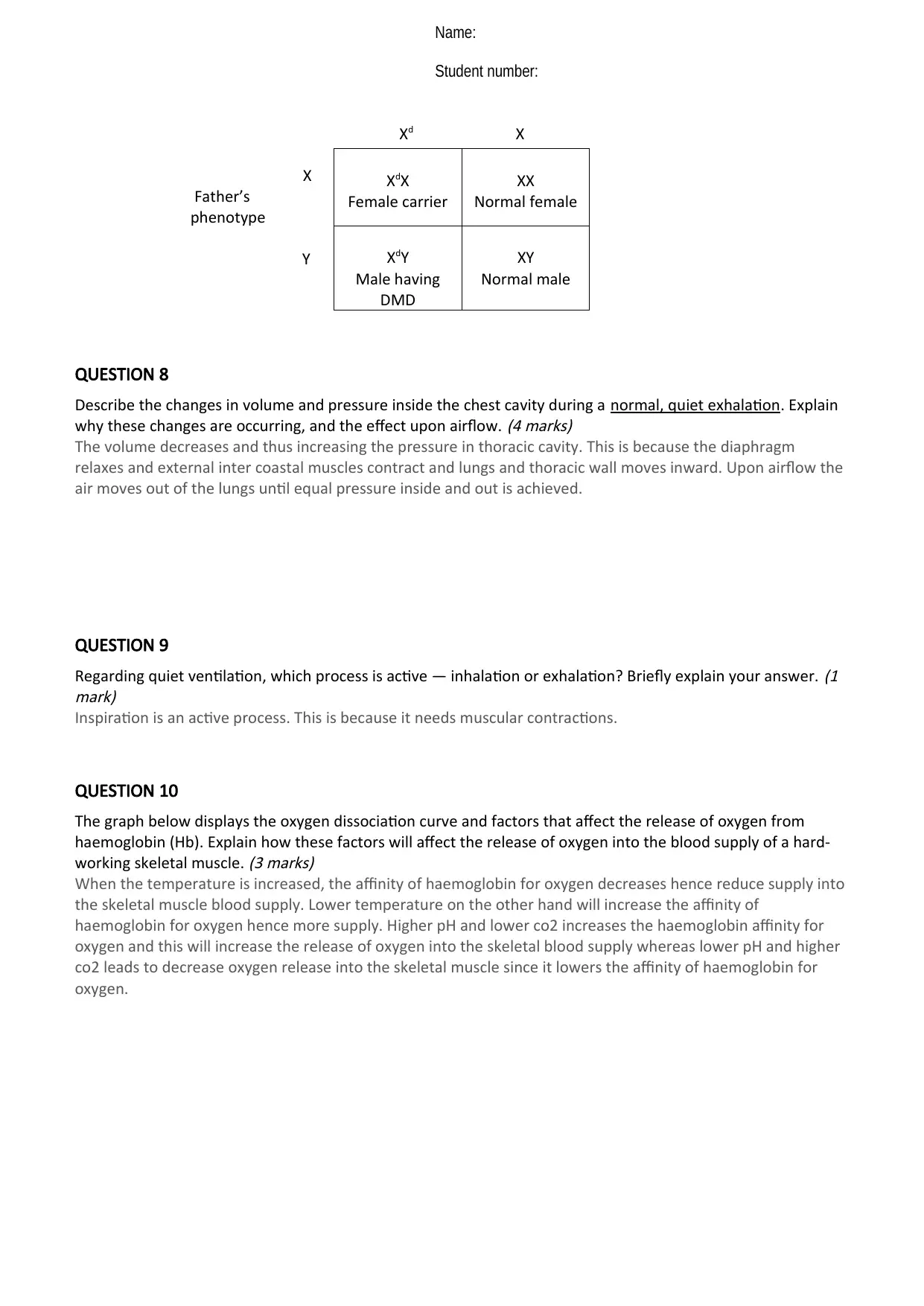
Name:
Student number:
Xd X
X
Father’s
phenotype
Y
QUESTION 8
Describe the changes in volume and pressure inside the chest cavity during a normal, quiet exhalation. Explain
why these changes are occurring, and the effect upon airflow.
(4 marks)
The volume decreases and thus increasing the pressure in thoracic cavity. This is because the diaphragm
relaxes and external inter coastal muscles contract and lungs and thoracic wall moves inward. Upon airflow the
air moves out of the lungs until equal pressure inside and out is achieved.
QUESTION 9
Regarding quiet ventilation, which process is active — inhalation or exhalation? Briefly explain your answer.
(1
mark)
Inspiration is an active process. This is because it needs muscular contractions.
QUESTION 10
The graph below displays the oxygen dissociation curve and factors that affect the release of oxygen from
haemoglobin (Hb). Explain how these factors will affect the release of oxygen into the blood supply of a hard-
working skeletal muscle.
(3 marks)
When the temperature is increased, the affinity of haemoglobin for oxygen decreases hence reduce supply into
the skeletal muscle blood supply. Lower temperature on the other hand will increase the affinity of
haemoglobin for oxygen hence more supply. Higher pH and lower co2 increases the haemoglobin affinity for
oxygen and this will increase the release of oxygen into the skeletal blood supply whereas lower pH and higher
co2 leads to decrease oxygen release into the skeletal muscle since it lowers the affinity of haemoglobin for
oxygen.
XdX
Female carrier
XX
Normal female
XdY
Male having
DMD
XY
Normal male
Student number:
Xd X
X
Father’s
phenotype
Y
QUESTION 8
Describe the changes in volume and pressure inside the chest cavity during a normal, quiet exhalation. Explain
why these changes are occurring, and the effect upon airflow.
(4 marks)
The volume decreases and thus increasing the pressure in thoracic cavity. This is because the diaphragm
relaxes and external inter coastal muscles contract and lungs and thoracic wall moves inward. Upon airflow the
air moves out of the lungs until equal pressure inside and out is achieved.
QUESTION 9
Regarding quiet ventilation, which process is active — inhalation or exhalation? Briefly explain your answer.
(1
mark)
Inspiration is an active process. This is because it needs muscular contractions.
QUESTION 10
The graph below displays the oxygen dissociation curve and factors that affect the release of oxygen from
haemoglobin (Hb). Explain how these factors will affect the release of oxygen into the blood supply of a hard-
working skeletal muscle.
(3 marks)
When the temperature is increased, the affinity of haemoglobin for oxygen decreases hence reduce supply into
the skeletal muscle blood supply. Lower temperature on the other hand will increase the affinity of
haemoglobin for oxygen hence more supply. Higher pH and lower co2 increases the haemoglobin affinity for
oxygen and this will increase the release of oxygen into the skeletal blood supply whereas lower pH and higher
co2 leads to decrease oxygen release into the skeletal muscle since it lowers the affinity of haemoglobin for
oxygen.
XdX
Female carrier
XX
Normal female
XdY
Male having
DMD
XY
Normal male
Secure Best Marks with AI Grader
Need help grading? Try our AI Grader for instant feedback on your assignments.
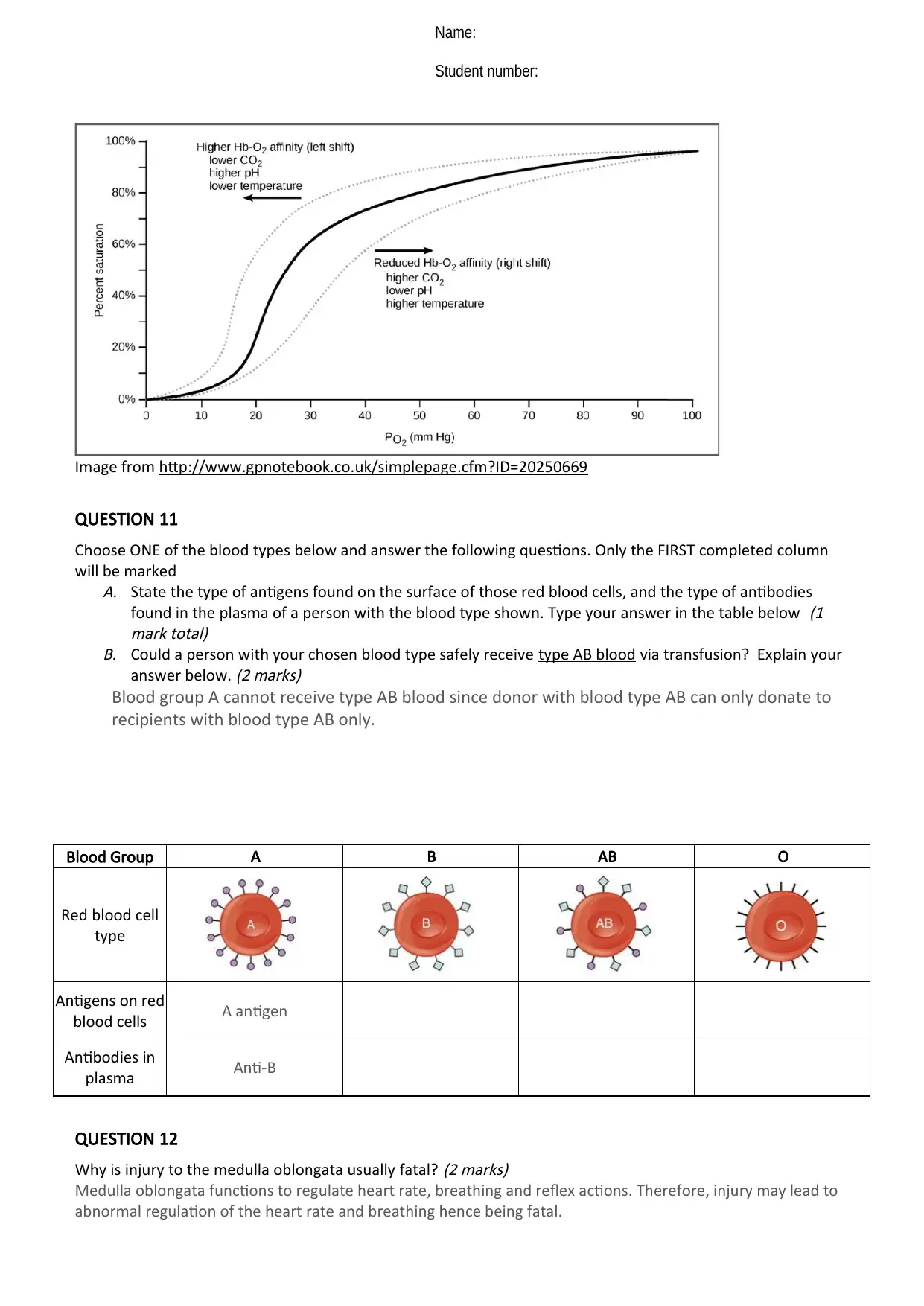
Name:
Student number:
Image from http://www.gpnotebook.co.uk/simplepage.cfm?ID=20250669
QUESTION 11
Choose ONE of the blood types below and answer the following questions. Only the FIRST completed column
will be markedA. State the type of antigens found on the surface of those red blood cells, and the type of antibodies
found in the plasma of a person with the blood type shown. Type your answer in the table below
(1
mark total)
B. Could a person with your chosen blood type safely receive type AB blood via transfusion? Explain your
answer below.
(2 marks)
Blood group A cannot receive type AB blood since donor with blood type AB can only donate to
recipients with blood type AB only.
Blood Group A B AB O
Red blood cell
type
Antigens on red
blood cells A antigen
Antibodies in
plasma Anti-B
QUESTION 12
Why is injury to the medulla oblongata usually fatal?
(2 marks)
Medulla oblongata functions to regulate heart rate, breathing and reflex actions. Therefore, injury may lead to
abnormal regulation of the heart rate and breathing hence being fatal.
Student number:
Image from http://www.gpnotebook.co.uk/simplepage.cfm?ID=20250669
QUESTION 11
Choose ONE of the blood types below and answer the following questions. Only the FIRST completed column
will be markedA. State the type of antigens found on the surface of those red blood cells, and the type of antibodies
found in the plasma of a person with the blood type shown. Type your answer in the table below
(1
mark total)
B. Could a person with your chosen blood type safely receive type AB blood via transfusion? Explain your
answer below.
(2 marks)
Blood group A cannot receive type AB blood since donor with blood type AB can only donate to
recipients with blood type AB only.
Blood Group A B AB O
Red blood cell
type
Antigens on red
blood cells A antigen
Antibodies in
plasma Anti-B
QUESTION 12
Why is injury to the medulla oblongata usually fatal?
(2 marks)
Medulla oblongata functions to regulate heart rate, breathing and reflex actions. Therefore, injury may lead to
abnormal regulation of the heart rate and breathing hence being fatal.
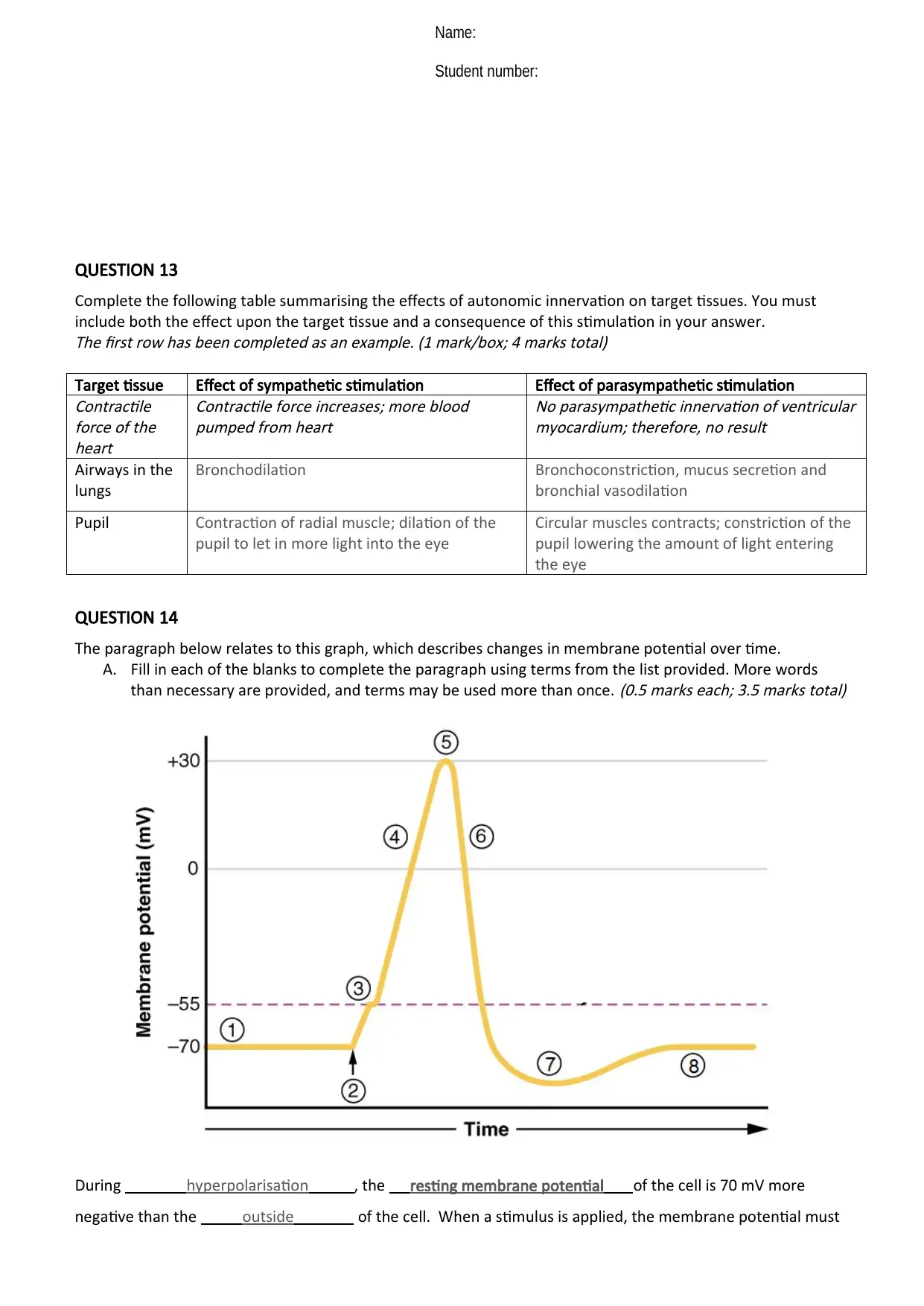
Name:
Student number:
QUESTION 13
Complete the following table summarising the effects of autonomic innervation on target tissues. You must
include both the effect upon the target tissue and a consequence of this stimulation in your answer.The first row has been completed as an example. (1 mark/box; 4 marks total)
Target tissue Effect of sympathetic stimulation Effect of parasympathetic stimulationContractile
force of the
heart
Contractile force increases; more blood
pumped from heart
No parasympathetic innervation of ventricular
myocardium; therefore, no result
Airways in the
lungs
Bronchodilation Bronchoconstriction, mucus secretion and
bronchial vasodilation
Pupil Contraction of radial muscle; dilation of the
pupil to let in more light into the eye
Circular muscles contracts; constriction of the
pupil lowering the amount of light entering
the eye
QUESTION 14
The paragraph below relates to this graph, which describes changes in membrane potential over time.
A. Fill in each of the blanks to complete the paragraph using terms from the list provided. More words
than necessary are provided, and terms may be used more than once.
(0.5 marks each; 3.5 marks total)
During hyperpolarisation , the resting membrane potential of the cell is 70 mV more
negative than the outside of the cell. When a stimulus is applied, the membrane potential must
Student number:
QUESTION 13
Complete the following table summarising the effects of autonomic innervation on target tissues. You must
include both the effect upon the target tissue and a consequence of this stimulation in your answer.The first row has been completed as an example. (1 mark/box; 4 marks total)
Target tissue Effect of sympathetic stimulation Effect of parasympathetic stimulationContractile
force of the
heart
Contractile force increases; more blood
pumped from heart
No parasympathetic innervation of ventricular
myocardium; therefore, no result
Airways in the
lungs
Bronchodilation Bronchoconstriction, mucus secretion and
bronchial vasodilation
Pupil Contraction of radial muscle; dilation of the
pupil to let in more light into the eye
Circular muscles contracts; constriction of the
pupil lowering the amount of light entering
the eye
QUESTION 14
The paragraph below relates to this graph, which describes changes in membrane potential over time.
A. Fill in each of the blanks to complete the paragraph using terms from the list provided. More words
than necessary are provided, and terms may be used more than once.
(0.5 marks each; 3.5 marks total)
During hyperpolarisation , the resting membrane potential of the cell is 70 mV more
negative than the outside of the cell. When a stimulus is applied, the membrane potential must
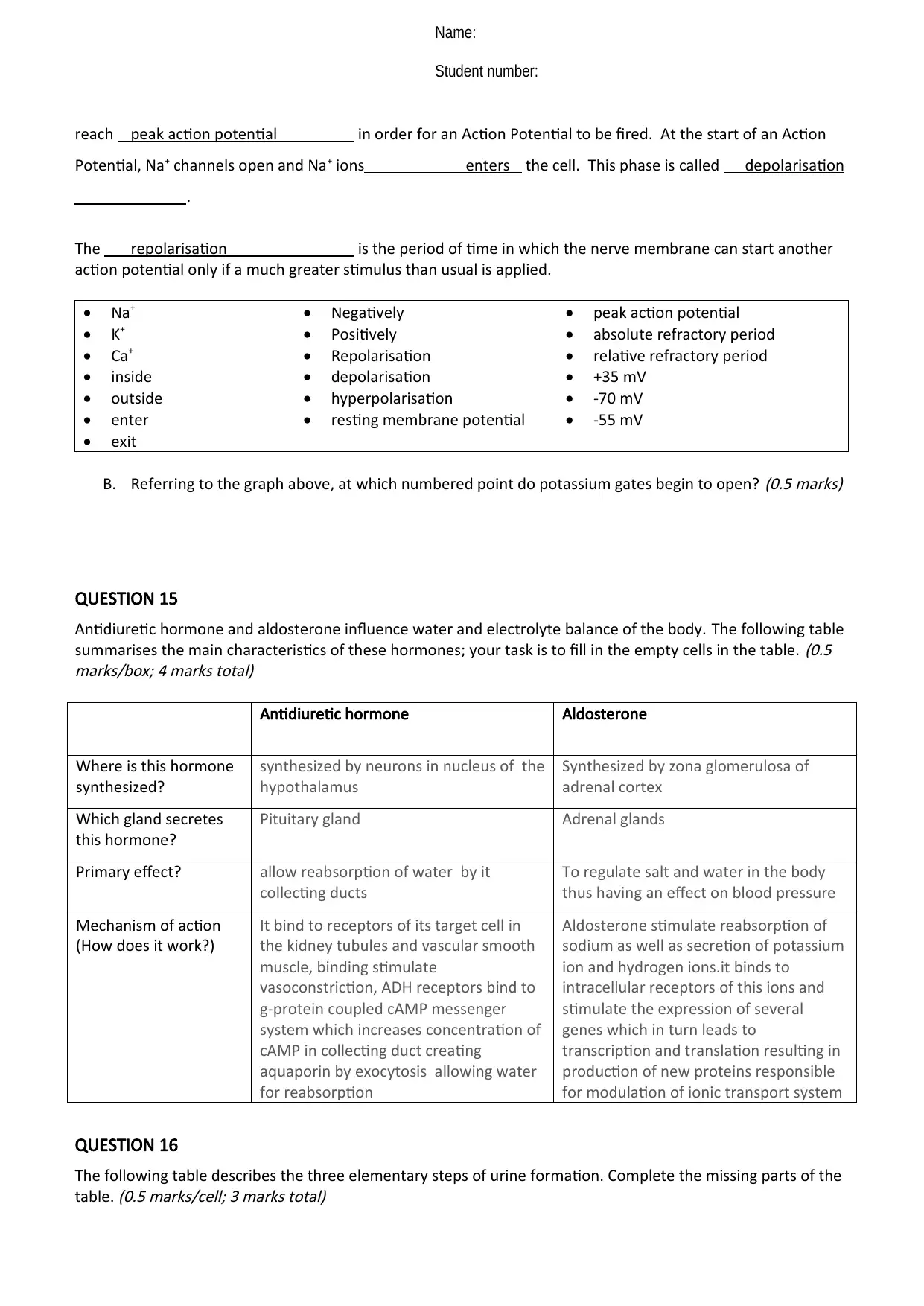
Name:
Student number:
reach peak action potential in order for an Action Potential to be fired. At the start of an Action
Potential, Na+ channels open and Na+ ions enters the cell. This phase is called depolarisation
.
The repolarisation is the period of time in which the nerve membrane can start another
action potential only if a much greater stimulus than usual is applied.
Na+ Negatively peak action potential
K+ Positively absolute refractory period
Ca+ Repolarisation relative refractory period
inside depolarisation +35 mV
outside
enter
exit
hyperpolarisation
resting membrane potential
-70 mV
-55 mV
B. Referring to the graph above, at which numbered point do potassium gates begin to open?
(0.5 marks)
QUESTION 15
Antidiuretic hormone and aldosterone influence water and electrolyte balance of the body. The following table
summarises the main characteristics of these hormones; your task is to fill in the empty cells in the table.
(0.5
marks/box; 4 marks total)
Antidiuretic hormone Aldosterone
Where is this hormone
synthesized?
synthesized by neurons in nucleus of the
hypothalamus
Synthesized by zona glomerulosa of
adrenal cortex
Which gland secretes
this hormone?
Pituitary gland Adrenal glands
Primary effect? allow reabsorption of water by it
collecting ducts
To regulate salt and water in the body
thus having an effect on blood pressure
Mechanism of action
(How does it work?)
It bind to receptors of its target cell in
the kidney tubules and vascular smooth
muscle, binding stimulate
vasoconstriction, ADH receptors bind to
g-protein coupled cAMP messenger
system which increases concentration of
cAMP in collecting duct creating
aquaporin by exocytosis allowing water
for reabsorption
Aldosterone stimulate reabsorption of
sodium as well as secretion of potassium
ion and hydrogen ions.it binds to
intracellular receptors of this ions and
stimulate the expression of several
genes which in turn leads to
transcription and translation resulting in
production of new proteins responsible
for modulation of ionic transport system
QUESTION 16
The following table describes the three elementary steps of urine formation. Complete the missing parts of the
table.
(0.5 marks/cell; 3 marks total)
Student number:
reach peak action potential in order for an Action Potential to be fired. At the start of an Action
Potential, Na+ channels open and Na+ ions enters the cell. This phase is called depolarisation
.
The repolarisation is the period of time in which the nerve membrane can start another
action potential only if a much greater stimulus than usual is applied.
Na+ Negatively peak action potential
K+ Positively absolute refractory period
Ca+ Repolarisation relative refractory period
inside depolarisation +35 mV
outside
enter
exit
hyperpolarisation
resting membrane potential
-70 mV
-55 mV
B. Referring to the graph above, at which numbered point do potassium gates begin to open?
(0.5 marks)
QUESTION 15
Antidiuretic hormone and aldosterone influence water and electrolyte balance of the body. The following table
summarises the main characteristics of these hormones; your task is to fill in the empty cells in the table.
(0.5
marks/box; 4 marks total)
Antidiuretic hormone Aldosterone
Where is this hormone
synthesized?
synthesized by neurons in nucleus of the
hypothalamus
Synthesized by zona glomerulosa of
adrenal cortex
Which gland secretes
this hormone?
Pituitary gland Adrenal glands
Primary effect? allow reabsorption of water by it
collecting ducts
To regulate salt and water in the body
thus having an effect on blood pressure
Mechanism of action
(How does it work?)
It bind to receptors of its target cell in
the kidney tubules and vascular smooth
muscle, binding stimulate
vasoconstriction, ADH receptors bind to
g-protein coupled cAMP messenger
system which increases concentration of
cAMP in collecting duct creating
aquaporin by exocytosis allowing water
for reabsorption
Aldosterone stimulate reabsorption of
sodium as well as secretion of potassium
ion and hydrogen ions.it binds to
intracellular receptors of this ions and
stimulate the expression of several
genes which in turn leads to
transcription and translation resulting in
production of new proteins responsible
for modulation of ionic transport system
QUESTION 16
The following table describes the three elementary steps of urine formation. Complete the missing parts of the
table.
(0.5 marks/cell; 3 marks total)
Paraphrase This Document
Need a fresh take? Get an instant paraphrase of this document with our AI Paraphraser
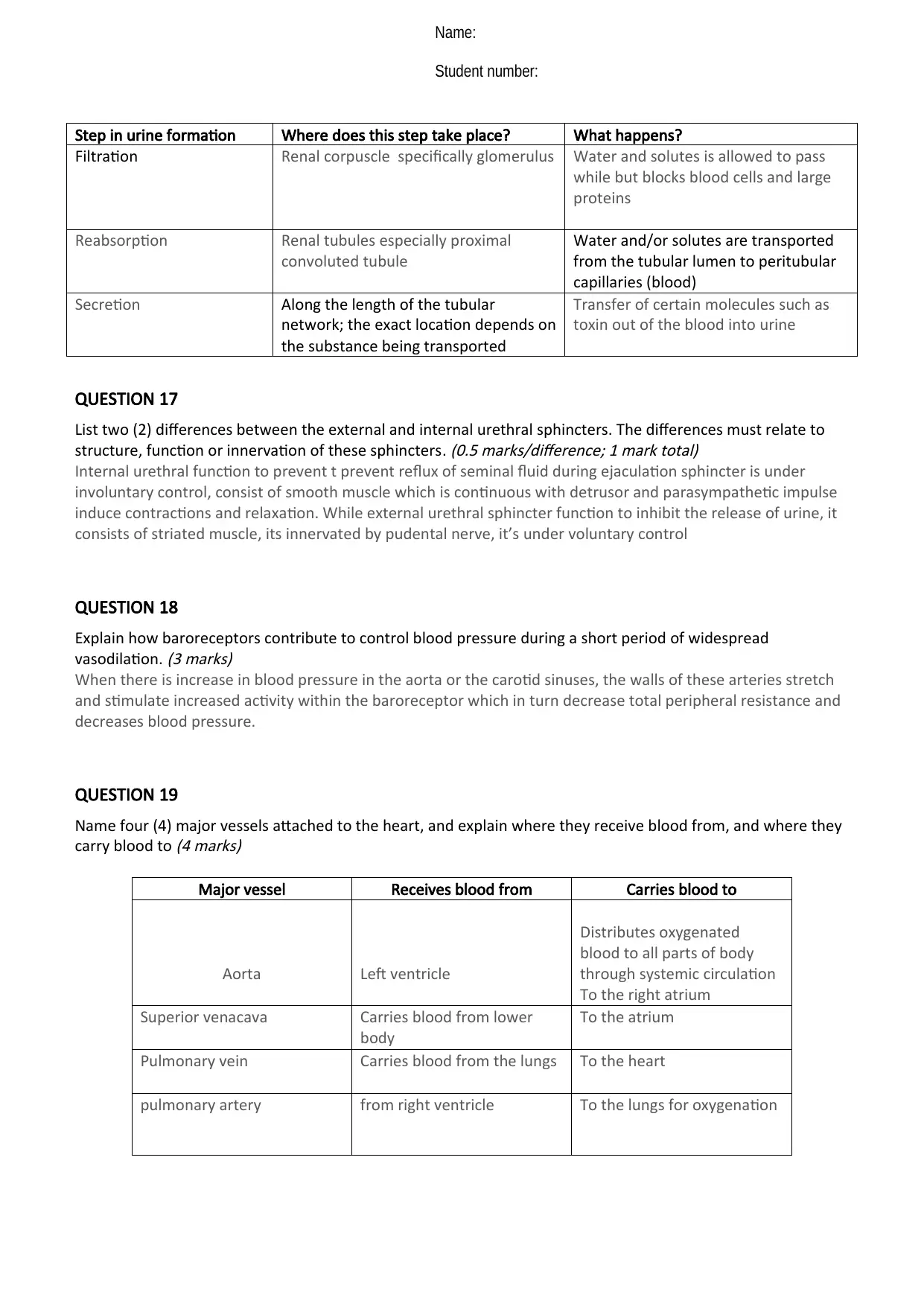
Name:
Student number:
Step in urine formation Where does this step take place? What happens?
Filtration Renal corpuscle specifically glomerulus Water and solutes is allowed to pass
while but blocks blood cells and large
proteins
Reabsorption Renal tubules especially proximal
convoluted tubule
Water and/or solutes are transported
from the tubular lumen to peritubular
capillaries (blood)
Secretion Along the length of the tubular
network; the exact location depends on
the substance being transported
Transfer of certain molecules such as
toxin out of the blood into urine
QUESTION 17
List two (2) differences between the external and internal urethral sphincters. The differences must relate to
structure, function or innervation of these sphincters.
(0.5 marks/difference; 1 mark total)
Internal urethral function to prevent t prevent reflux of seminal fluid during ejaculation sphincter is under
involuntary control, consist of smooth muscle which is continuous with detrusor and parasympathetic impulse
induce contractions and relaxation. While external urethral sphincter function to inhibit the release of urine, it
consists of striated muscle, its innervated by pudental nerve, it’s under voluntary control
QUESTION 18
Explain how baroreceptors contribute to control blood pressure during a short period of widespread
vasodilation.
(3 marks)
When there is increase in blood pressure in the aorta or the carotid sinuses, the walls of these arteries stretch
and stimulate increased activity within the baroreceptor which in turn decrease total peripheral resistance and
decreases blood pressure.
QUESTION 19
Name four (4) major vessels attached to the heart, and explain where they receive blood from, and where they
carry blood to
(4 marks)
Major vessel Receives blood from Carries blood to
Aorta Left ventricle
Distributes oxygenated
blood to all parts of body
through systemic circulation
To the right atrium
Superior venacava Carries blood from lower
body
To the atrium
Pulmonary vein Carries blood from the lungs To the heart
pulmonary artery from right ventricle To the lungs for oxygenation
Student number:
Step in urine formation Where does this step take place? What happens?
Filtration Renal corpuscle specifically glomerulus Water and solutes is allowed to pass
while but blocks blood cells and large
proteins
Reabsorption Renal tubules especially proximal
convoluted tubule
Water and/or solutes are transported
from the tubular lumen to peritubular
capillaries (blood)
Secretion Along the length of the tubular
network; the exact location depends on
the substance being transported
Transfer of certain molecules such as
toxin out of the blood into urine
QUESTION 17
List two (2) differences between the external and internal urethral sphincters. The differences must relate to
structure, function or innervation of these sphincters.
(0.5 marks/difference; 1 mark total)
Internal urethral function to prevent t prevent reflux of seminal fluid during ejaculation sphincter is under
involuntary control, consist of smooth muscle which is continuous with detrusor and parasympathetic impulse
induce contractions and relaxation. While external urethral sphincter function to inhibit the release of urine, it
consists of striated muscle, its innervated by pudental nerve, it’s under voluntary control
QUESTION 18
Explain how baroreceptors contribute to control blood pressure during a short period of widespread
vasodilation.
(3 marks)
When there is increase in blood pressure in the aorta or the carotid sinuses, the walls of these arteries stretch
and stimulate increased activity within the baroreceptor which in turn decrease total peripheral resistance and
decreases blood pressure.
QUESTION 19
Name four (4) major vessels attached to the heart, and explain where they receive blood from, and where they
carry blood to
(4 marks)
Major vessel Receives blood from Carries blood to
Aorta Left ventricle
Distributes oxygenated
blood to all parts of body
through systemic circulation
To the right atrium
Superior venacava Carries blood from lower
body
To the atrium
Pulmonary vein Carries blood from the lungs To the heart
pulmonary artery from right ventricle To the lungs for oxygenation
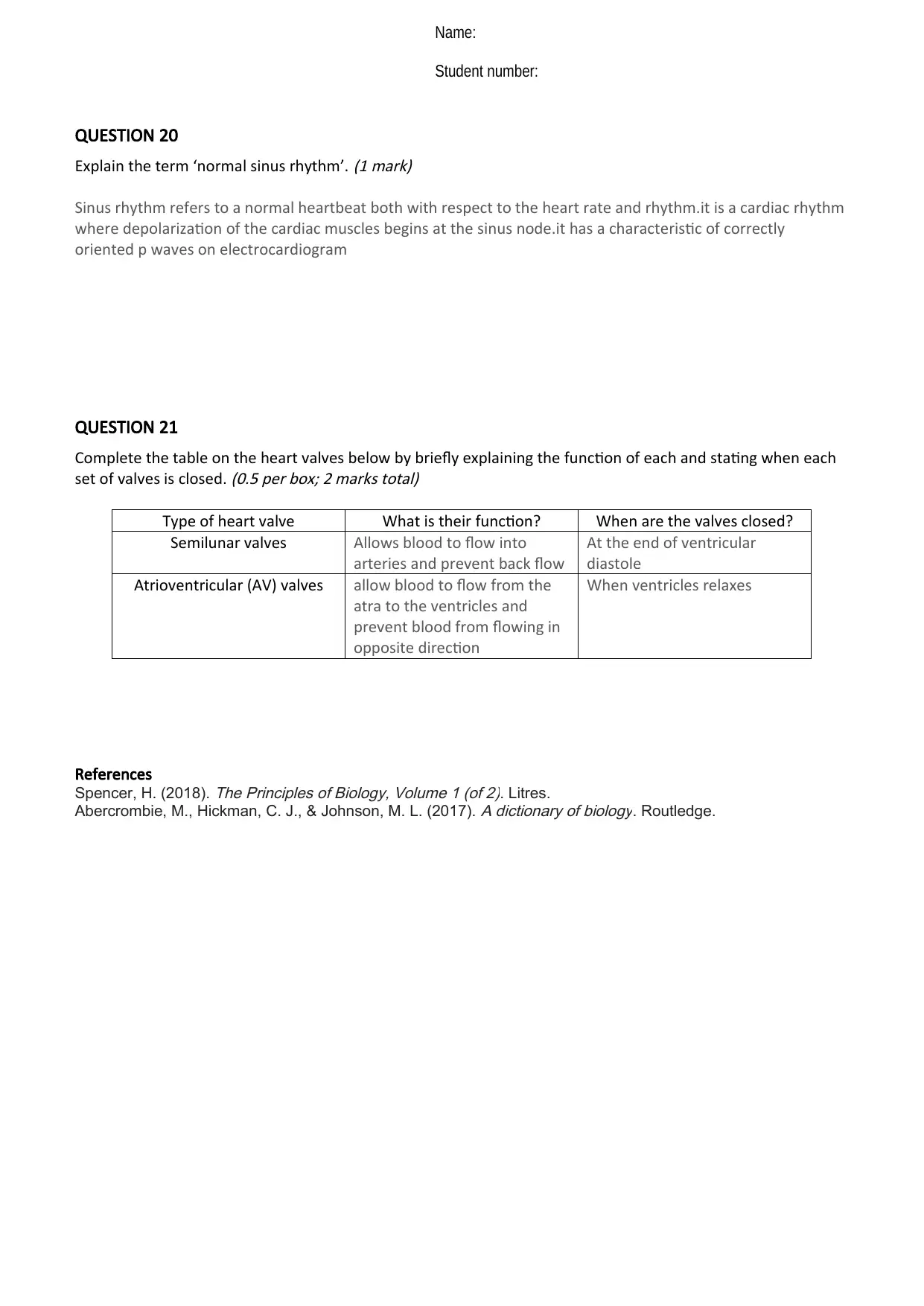
Name:
Student number:
QUESTION 20
Explain the term ‘normal sinus rhythm’.
(1 mark)
Sinus rhythm refers to a normal heartbeat both with respect to the heart rate and rhythm.it is a cardiac rhythm
where depolarization of the cardiac muscles begins at the sinus node.it has a characteristic of correctly
oriented p waves on electrocardiogram
QUESTION 21
Complete the table on the heart valves below by briefly explaining the function of each and stating when each
set of valves is closed.
(0.5 per box; 2 marks total)
Type of heart valve What is their function? When are the valves closed?
Semilunar valves Allows blood to flow into
arteries and prevent back flow
At the end of ventricular
diastole
Atrioventricular (AV) valves allow blood to flow from the
atra to the ventricles and
prevent blood from flowing in
opposite direction
When ventricles relaxes
References
Spencer, H. (2018).
The Principles of Biology, Volume 1 (of 2). Litres.
Abercrombie, M., Hickman, C. J., & Johnson, M. L. (2017).
A dictionary of biology. Routledge.
Student number:
QUESTION 20
Explain the term ‘normal sinus rhythm’.
(1 mark)
Sinus rhythm refers to a normal heartbeat both with respect to the heart rate and rhythm.it is a cardiac rhythm
where depolarization of the cardiac muscles begins at the sinus node.it has a characteristic of correctly
oriented p waves on electrocardiogram
QUESTION 21
Complete the table on the heart valves below by briefly explaining the function of each and stating when each
set of valves is closed.
(0.5 per box; 2 marks total)
Type of heart valve What is their function? When are the valves closed?
Semilunar valves Allows blood to flow into
arteries and prevent back flow
At the end of ventricular
diastole
Atrioventricular (AV) valves allow blood to flow from the
atra to the ventricles and
prevent blood from flowing in
opposite direction
When ventricles relaxes
References
Spencer, H. (2018).
The Principles of Biology, Volume 1 (of 2). Litres.
Abercrombie, M., Hickman, C. J., & Johnson, M. L. (2017).
A dictionary of biology. Routledge.
1 out of 9
Related Documents
Your All-in-One AI-Powered Toolkit for Academic Success.
+13062052269
info@desklib.com
Available 24*7 on WhatsApp / Email
![[object Object]](/_next/static/media/star-bottom.7253800d.svg)
Unlock your academic potential
© 2024 | Zucol Services PVT LTD | All rights reserved.
